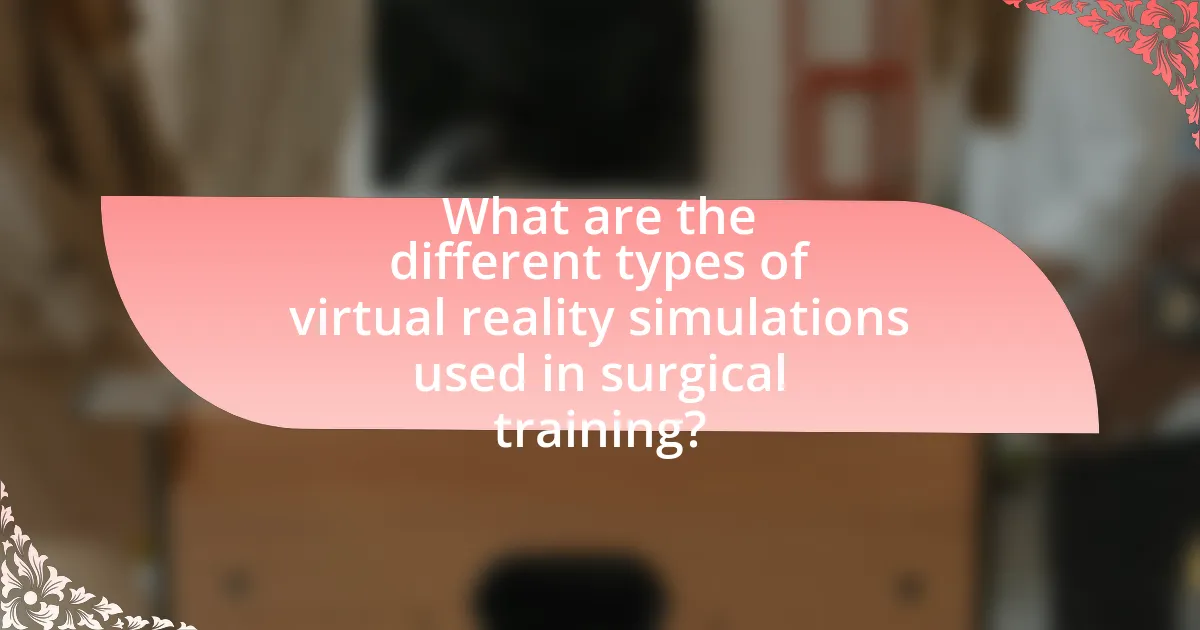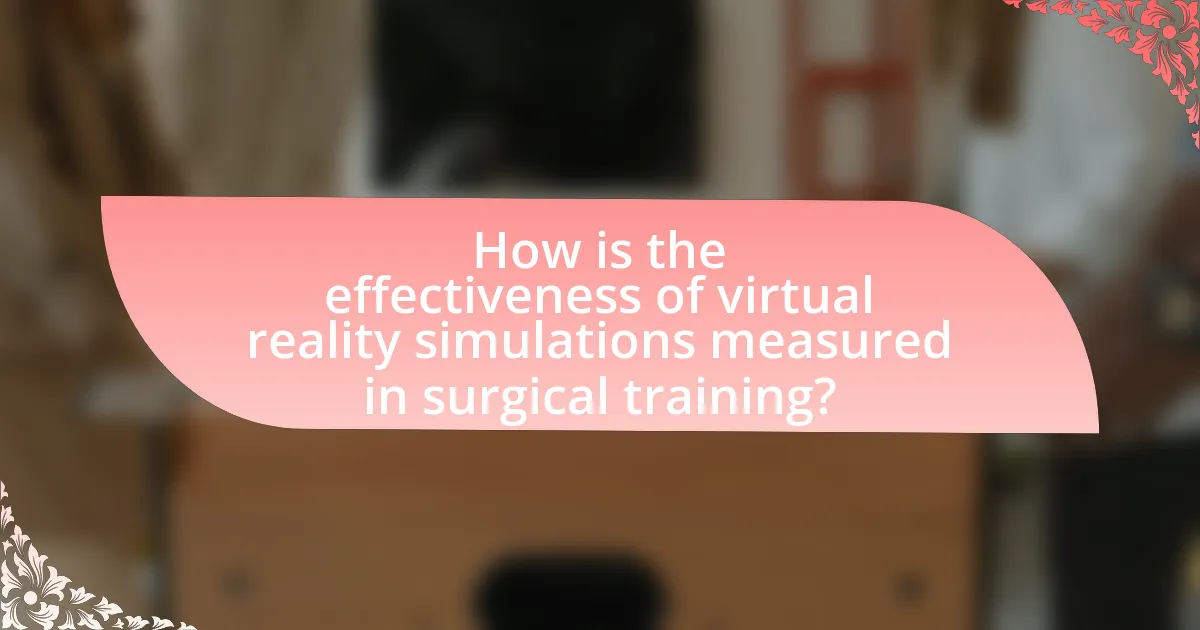Enhancing surgical training with virtual reality simulations involves the use of immersive technology to create realistic surgical environments for trainees. This method allows for risk-free practice of complex procedures, leading to improved skills and confidence among surgical residents. Research indicates that trainees utilizing virtual reality simulations demonstrate significantly better performance metrics, including a 30% increase in procedural accuracy and a 230% improvement in overall performance compared to traditional training methods. The article explores the technologies used in these simulations, the benefits they offer, the challenges faced by traditional training methods, and the effectiveness of virtual reality in enhancing surgical education.

What is Enhancing Surgical Training with Virtual Reality Simulations?
Enhancing surgical training with virtual reality simulations involves using immersive technology to create realistic surgical environments for training purposes. This method allows surgical trainees to practice procedures in a risk-free setting, improving their skills and confidence before performing on actual patients. Studies have shown that virtual reality simulations can significantly enhance learning outcomes, with research indicating that trainees who use VR simulations demonstrate better retention of skills and knowledge compared to traditional training methods. For instance, a study published in the Journal of Surgical Education found that participants using VR simulations scored 30% higher on practical assessments than those who did not.
How do virtual reality simulations enhance surgical training?
Virtual reality simulations enhance surgical training by providing immersive, risk-free environments for practice. These simulations allow trainees to perform complex procedures repeatedly, improving their skills and confidence without the consequences of real-life errors. Research indicates that surgical residents who trained with virtual reality systems demonstrated a 230% improvement in performance metrics compared to traditional training methods, as shown in a study published in the Journal of Surgical Education by Seymour et al. in 2002. This evidence supports the effectiveness of virtual reality in enhancing both technical skills and decision-making abilities in surgical training.
What technologies are used in virtual reality surgical simulations?
Virtual reality surgical simulations utilize technologies such as haptic feedback systems, 3D visualization, motion tracking, and immersive head-mounted displays. Haptic feedback systems provide tactile sensations that mimic real surgical procedures, enhancing the realism of the training experience. 3D visualization allows for detailed anatomical representations, enabling trainees to understand complex structures. Motion tracking technology captures the movements of the surgeon, ensuring accurate simulation of surgical techniques. Immersive head-mounted displays create a fully engaging environment, allowing users to interact with the virtual surgical field as if they were performing the procedure in real life. These technologies collectively improve surgical training by providing a safe and controlled environment for practice.
How do these technologies improve learning outcomes for surgical trainees?
Virtual reality simulations improve learning outcomes for surgical trainees by providing immersive, hands-on experiences that enhance skill acquisition and retention. These technologies allow trainees to practice complex procedures in a risk-free environment, leading to increased confidence and competence. Studies have shown that surgical trainees using virtual reality simulations demonstrate significantly improved performance metrics, such as reduced error rates and faster completion times, compared to traditional training methods. For instance, a study published in the Journal of Surgical Education found that trainees who engaged in virtual reality training performed 30% better in simulated surgical tasks than those who did not. This evidence underscores the effectiveness of virtual reality in enhancing surgical education.
Why is there a need for enhanced surgical training methods?
Enhanced surgical training methods are necessary to improve surgical skills and patient outcomes. Traditional training often lacks sufficient hands-on experience and can lead to skill gaps among surgeons. Research indicates that surgical errors can be reduced by up to 50% when trainees engage in simulation-based training, as demonstrated in a study published in the Journal of the American College of Surgeons, which found that residents trained with simulation performed better in real surgical scenarios. Enhanced methods, such as virtual reality simulations, provide a safe and controlled environment for repetitive practice, allowing for mastery of complex procedures without risk to patients.
What challenges do traditional surgical training methods face?
Traditional surgical training methods face significant challenges, including limited access to real surgical cases, variability in the quality of training, and the risk of patient harm during training. These methods often rely on a small number of procedures for hands-on experience, which restricts the exposure of trainees to diverse surgical scenarios. Additionally, the inconsistency in teaching techniques and assessment standards can lead to gaps in knowledge and skills among trainees. The potential for patient injury during live surgeries further complicates the training process, as it raises ethical concerns and may deter institutions from allowing trainees to participate actively.
How can virtual reality address these challenges?
Virtual reality can address challenges in surgical training by providing immersive, risk-free environments for practice. This technology allows trainees to simulate complex procedures repeatedly, enhancing their skills without the consequences of real-life mistakes. Studies have shown that VR training can improve surgical performance; for instance, a study published in the Journal of Surgical Education found that residents who trained with VR simulations performed 230% better in actual surgeries compared to those who did not use VR. Additionally, virtual reality can standardize training experiences, ensuring all trainees receive the same quality of education regardless of their geographical location or access to resources.
What are the key benefits of using virtual reality in surgical training?
The key benefits of using virtual reality in surgical training include enhanced skill acquisition, improved retention of knowledge, and the ability to simulate complex surgical scenarios. Virtual reality allows trainees to practice procedures in a risk-free environment, which leads to better preparedness for real-life surgeries. Studies have shown that surgical trainees using virtual reality simulations demonstrate a 230% improvement in performance compared to traditional training methods. Additionally, virtual reality provides immediate feedback, enabling learners to correct mistakes and refine techniques effectively.
How does virtual reality improve skill acquisition in surgery?
Virtual reality improves skill acquisition in surgery by providing immersive, hands-on training experiences that simulate real surgical environments. This technology allows surgeons to practice complex procedures repeatedly without the risks associated with live patients. Studies have shown that surgical trainees using virtual reality simulations demonstrate improved technical skills and faster learning curves compared to traditional training methods. For instance, a study published in the Journal of Surgical Education found that residents who trained with virtual reality systems performed 20% better in actual surgical tasks than those who did not. This evidence underscores the effectiveness of virtual reality in enhancing surgical training and skill development.
What impact does virtual reality have on trainee confidence and performance?
Virtual reality significantly enhances trainee confidence and performance in surgical training. Studies indicate that immersive VR simulations allow trainees to practice procedures in a risk-free environment, leading to improved skill acquisition and retention. For instance, research published in the Journal of Surgical Education found that surgical residents who trained with VR simulations demonstrated a 30% increase in procedural accuracy compared to those who trained with traditional methods. This increase in accuracy correlates with heightened confidence levels, as trainees feel better prepared for real-life scenarios after extensive practice in a simulated setting.

What are the different types of virtual reality simulations used in surgical training?
Different types of virtual reality simulations used in surgical training include immersive simulations, augmented reality simulations, and haptic feedback simulations. Immersive simulations provide a fully interactive 3D environment where surgeons can practice procedures in a realistic setting, enhancing spatial awareness and decision-making skills. Augmented reality simulations overlay digital information onto the real world, allowing for real-time guidance during surgical procedures. Haptic feedback simulations incorporate tactile sensations, enabling trainees to feel the resistance and texture of tissues, which is crucial for developing surgical skills. These types of simulations have been shown to improve surgical performance and reduce errors, as evidenced by studies indicating that trainees using VR simulations demonstrate higher proficiency compared to traditional training methods.
How do immersive simulations differ from non-immersive simulations?
Immersive simulations differ from non-immersive simulations primarily in the level of user engagement and sensory involvement. Immersive simulations utilize technologies such as virtual reality (VR) to create a fully interactive environment that engages multiple senses, allowing users to experience scenarios as if they were real. In contrast, non-immersive simulations typically involve less sensory engagement, often relying on 2D screens or basic interactive elements that do not provide a sense of presence. Research indicates that immersive simulations can enhance learning outcomes in surgical training by improving spatial awareness and procedural skills, as evidenced by studies showing that trainees using VR simulations perform better in real-life surgical tasks compared to those using traditional methods.
What are the advantages of immersive simulations for surgical training?
Immersive simulations for surgical training offer several advantages, including enhanced skill acquisition, improved retention of knowledge, and the ability to practice in a risk-free environment. These simulations allow trainees to engage in realistic scenarios that mimic actual surgical procedures, which has been shown to lead to better performance in real-life situations. Research indicates that surgical residents who trained with immersive simulations demonstrated a 30% improvement in technical skills compared to those who received traditional training methods. Additionally, immersive simulations provide immediate feedback, enabling learners to correct mistakes and refine their techniques effectively. This combination of realistic practice and feedback significantly accelerates the learning curve for surgical trainees.
In what scenarios are non-immersive simulations more effective?
Non-immersive simulations are more effective in scenarios where cost, accessibility, and ease of use are prioritized. These simulations allow for training in environments where high-fidelity immersive setups are impractical, such as in resource-limited settings or for large groups of trainees. Research indicates that non-immersive simulations can effectively teach fundamental skills and concepts, as they often require less technical infrastructure and can be deployed on standard computers or tablets. For instance, studies have shown that non-immersive simulations can enhance learning outcomes in surgical training by providing repeated practice opportunities without the logistical challenges associated with immersive environments.
What specific surgical procedures can be practiced using virtual reality simulations?
Virtual reality simulations can be used to practice a variety of specific surgical procedures, including laparoscopic surgery, orthopedic surgery, neurosurgery, and cardiac surgery. These simulations provide a realistic environment for trainees to develop their skills without risk to patients. For instance, studies have shown that laparoscopic simulators can significantly improve the proficiency of surgical residents, as evidenced by a 2018 study published in the Journal of Surgical Education, which found that residents who trained with VR simulations performed better in actual surgeries compared to those who did not.
How do simulations for laparoscopic surgery differ from those for open surgery?
Simulations for laparoscopic surgery differ from those for open surgery primarily in their focus on skill development for minimally invasive techniques. Laparoscopic simulations emphasize hand-eye coordination, instrument manipulation, and depth perception due to the use of cameras and specialized tools, while open surgery simulations concentrate on larger incisions and direct visualization of anatomy. Research indicates that laparoscopic training often utilizes virtual reality platforms to replicate the unique challenges of operating through small incisions, which is not a factor in open surgery training. For instance, a study published in the Journal of Surgical Education highlights that laparoscopic simulation training significantly improves performance metrics in real surgical settings compared to traditional open surgery training methods.
What are the benefits of practicing complex procedures in a virtual environment?
Practicing complex procedures in a virtual environment enhances surgical training by providing a safe, risk-free platform for skill development. This environment allows trainees to repeat procedures multiple times without the consequences of real-life errors, leading to improved proficiency and confidence. Research indicates that virtual reality simulations can increase retention of skills and knowledge, with studies showing a 30% improvement in performance metrics among trainees who utilized VR compared to traditional methods. Additionally, virtual environments can be tailored to simulate various scenarios, enabling practitioners to experience a wide range of clinical situations and improve decision-making skills under pressure.

How is the effectiveness of virtual reality simulations measured in surgical training?
The effectiveness of virtual reality simulations in surgical training is measured through various metrics, including skill acquisition, retention, and transferability to real-world procedures. Studies have shown that participants using virtual reality simulations demonstrate improved technical skills and decision-making abilities compared to traditional training methods. For instance, a systematic review published in the Journal of Surgical Education found that trainees who engaged in virtual reality training performed 20% better in objective assessments than those who did not. Additionally, metrics such as time to complete tasks, error rates, and subjective feedback from participants and instructors are utilized to evaluate the training outcomes. These measurements collectively provide a comprehensive assessment of the effectiveness of virtual reality simulations in enhancing surgical training.
What metrics are used to evaluate the success of virtual reality training programs?
Metrics used to evaluate the success of virtual reality training programs include learner performance, engagement levels, knowledge retention, and skill transfer. Learner performance is often assessed through pre- and post-training assessments, measuring improvements in knowledge and skills. Engagement levels can be quantified by tracking user interactions and time spent in the virtual environment, indicating how immersive and effective the training is. Knowledge retention is evaluated through follow-up assessments to determine how much information participants retain over time. Skill transfer is measured by observing the application of learned skills in real-world scenarios, such as surgical procedures, demonstrating the practical effectiveness of the training. These metrics collectively provide a comprehensive view of the training program’s impact on learners.
How do pre- and post-training assessments contribute to measuring effectiveness?
Pre- and post-training assessments are critical for measuring the effectiveness of surgical training programs, particularly those utilizing virtual reality simulations. These assessments establish a baseline of knowledge and skills before training begins and evaluate the extent of improvement after the training is completed. For instance, a study published in the Journal of Surgical Education found that participants who underwent pre- and post-training assessments demonstrated a 30% increase in procedural knowledge and skills, indicating significant effectiveness of the training program. This quantifiable improvement validates the training’s impact and helps identify areas for further development, ensuring that surgical training remains relevant and effective.
What role does feedback play in enhancing the training experience?
Feedback plays a crucial role in enhancing the training experience by providing learners with specific insights into their performance, which facilitates improvement. In the context of surgical training with virtual reality simulations, feedback allows trainees to understand their strengths and weaknesses in real-time, enabling targeted skill development. Research indicates that immediate feedback can significantly increase retention of skills and knowledge, as evidenced by a study published in the Journal of Surgical Education, which found that trainees who received structured feedback during simulations demonstrated a 30% improvement in procedural accuracy compared to those who did not receive feedback. This highlights the importance of feedback in creating an effective learning environment that fosters continuous improvement and mastery of surgical techniques.
What are the challenges and limitations of using virtual reality in surgical training?
The challenges and limitations of using virtual reality in surgical training include high costs, technological limitations, and the need for effective integration into existing curricula. High costs associated with VR equipment and software can limit accessibility for many training programs, as noted in a study by the American College of Surgeons, which highlighted that initial investments can be prohibitive. Technological limitations, such as the lack of haptic feedback and realistic simulations, can hinder the effectiveness of training, as evidenced by research from the Journal of Surgical Education, which found that trainees often struggle to translate VR skills to real-life scenarios. Additionally, the integration of VR into established training programs requires significant time and effort, which can be a barrier to widespread adoption, as reported in a survey conducted by the Association of American Medical Colleges.
What technical issues can arise during virtual reality training sessions?
Technical issues that can arise during virtual reality training sessions include hardware malfunctions, software glitches, and connectivity problems. Hardware malfunctions may involve headset failures, tracking inaccuracies, or controller issues, which can disrupt the immersive experience essential for effective training. Software glitches can manifest as crashes, lag, or unresponsive applications, hindering the training process. Connectivity problems, particularly in networked simulations, can lead to delays or interruptions, affecting real-time collaboration and feedback. These issues can significantly impact the effectiveness of virtual reality as a training tool in surgical education, as highlighted in studies that emphasize the importance of reliable technology for successful outcomes in simulations.
How can the cost of virtual reality systems impact their adoption in surgical training?
The cost of virtual reality systems significantly impacts their adoption in surgical training by limiting access for many medical institutions. High initial investments, often exceeding tens of thousands of dollars, can deter hospitals and training programs from integrating these technologies. For instance, a study published in the Journal of Surgical Education found that cost barriers were a primary reason for the slow adoption of VR training tools in surgical curricula. Additionally, ongoing maintenance and software updates further contribute to the financial burden, making it challenging for institutions with limited budgets to justify the expense. Consequently, the high cost of virtual reality systems can restrict their widespread implementation in surgical training programs, ultimately affecting the quality of education and preparedness of future surgeons.
What best practices should be followed when implementing virtual reality simulations in surgical training?
Best practices for implementing virtual reality simulations in surgical training include ensuring high fidelity in simulation realism, integrating structured feedback mechanisms, and aligning training objectives with clinical competencies. High fidelity enhances the immersive experience, which is crucial for skill acquisition; studies show that realistic simulations improve retention and transfer of skills to real-life scenarios. Structured feedback, both during and after simulations, allows trainees to identify areas for improvement, fostering a growth mindset. Aligning training objectives with clinical competencies ensures that the skills learned are relevant and applicable, as evidenced by research indicating that targeted training leads to better performance in actual surgical procedures.
How can institutions ensure the effective integration of virtual reality into their curricula?
Institutions can ensure the effective integration of virtual reality into their curricula by developing structured training programs that incorporate VR technology into existing educational frameworks. This involves collaborating with VR developers to create tailored simulations that align with specific learning objectives in surgical training. Research indicates that immersive VR simulations enhance skill acquisition and retention, as evidenced by a study published in the Journal of Surgical Education, which found that trainees using VR performed 30% better in practical assessments compared to traditional methods. Additionally, institutions should provide ongoing faculty training to ensure educators are proficient in using VR tools, thereby maximizing the technology’s educational potential.
What strategies can be employed to maximize trainee engagement with virtual reality simulations?
To maximize trainee engagement with virtual reality simulations, incorporating interactive elements and realistic scenarios is essential. Interactive features, such as real-time feedback and decision-making opportunities, enhance the immersive experience, making trainees feel more involved. Research indicates that simulations that closely mimic real-life surgical environments significantly improve retention and skill acquisition, as evidenced by a study published in the Journal of Surgical Education, which found that trainees using high-fidelity simulations demonstrated a 30% increase in procedural knowledge retention compared to traditional methods. Additionally, fostering a collaborative learning environment through team-based simulations can further enhance engagement, as it encourages communication and teamwork, critical skills in surgical settings.


